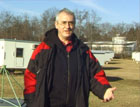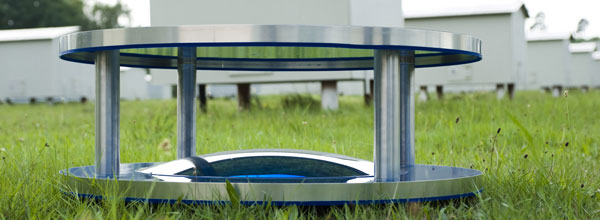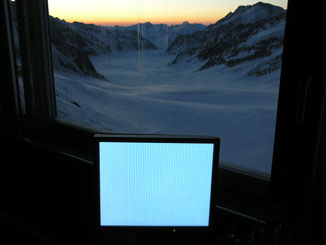Matter from Distant Worlds
It is a potpourri of rays originating from space which impact on the earth. Parts are blocked and absorbed by the magnetosphere and the atmosphere. Apart from electromagnetic radiation, e.g. the visible light, also high energetic nuclear particles hit the earth. For instance the hydrogen nuclei ejected by the sun as part of solar wind become noticeable as the polar light. With much higher energies charged particles travel through the galaxies accelerated at almost the speed of light. These completely ionized nuclei originate from exploding stars, the so called super novae.

Accelerator for cosmic particles are Super Novae. The crab nebula is a remnant of such a giant star explosion. It is one of the most studied astronomical object. Image: Hubble Space Telescope
Air Showers
Hitting the terrestrial atmosphere the cosmic particles interact with the atomic nuclear of the atmospheric gazes. The energies released by the collisions is transformed into a variety of elementary particles initiating a particle cascaded – the extended air showers. The KASCADE experiment located in Karlsruhe (south-west Germany) measures the resulting myons and electrons. According to its distribution and orientation a cosmic shower can be reconstructed. KASCADE measures cosmic particle with energies around 1014 up to 1017eV. The KASCADE-Grande experiment with its detector units distributed over the whole terrain of the North Campus of the KIT, energies even between 1014-1018eVcan be measured.

winter impression of the KASCADE field in Karlsruhe (D)
Auger
In 1996 KASCADE started operations. In 2007 a much larger experiment was launched in South-America. The Auger-Observatory The Auger Observatory extends across a terrain of 3000 square kilometres in the Argentinian Pampa. In 1600 water tanks the myon compound of showers is detected. The Institute of Nuclear Physics is involved in the international collaboration in the conception and construction for the fluorescence telescopes, the data acquisition and the trigger electronics. At the moment Auger is at the planning stage for the northern hemisphere to be realized even much larger in Colorado (USA). (More experiments...)
Black Holes
Compared with hitherto existing experiments the Auger Observatory can detect particles with much higher energies. The earth is hit since aeons by high energetic cosmic radiation. The highest energies are million times higher than the energies produced currently in the largest particle accelerators on earth. This is why the debate around the mini black holes at the CERN in Geneva refers to this energetic impact of cosmic radiation. If the postulated mini black holes resulting from collision in the accelerator at CERN would be really so dangerous, such a mini hole would have been created by a cosmic particle long ago and sucked up the whole planet. But black holes far away from our stellar system could be the cause for this highest energetic radiation. It is supposed, that active black holes in distant galaxies could be the source for these extreme particle energies physicists and astronomers are wondering about since decades.
 Andreas Haungs explains KASCADE and LOPES Andreas Haungs explains KASCADE and LOPES
(Clip:  Mpg, , 15 Mb, 1 min.) Mpg, , 15 Mb, 1 min.)
Lopes
If the trajectory of high energetic elementary particle is bent, the particles emit synchrotron radiation. This is not only a phenomenon in circular particle accelerators, but happens also when a charged cosmic particle is deflected by the terrestrial magnetosphere. Synchrotron radiation in the radio spectrum could be detected at the Institute of Nuclear Physics in 2004 correlating the data of the LOPES experiment and KASCADE-Grande. LOPES is a pilot project for the prospective largest radio array in Netherlands: LOFAR (Low-Frequency Array). In the final stage it will comprise more than hundred antenna field distributed over Netherlands, Germany and further European countries. LOPES (LOFAR PrototypE Station) consists of an array of 30 radio antenna, registering data in the spectrum of 40-80 MHz (corresponding to wavelengths between four and eight metres) to be correlated with the data of the KASCADE-experiment after.
Astroparticle physics and particle physics
What makes the research on cosmic particle quite tricky is the fact, that the induced air showers are relatively seldom. Above all you never know when and where such a shower might appear. This is why the research of astroparticle physics and particle physics complement one another. Experiments like at the LHC in Geneva or at the GSI in Darmstadt which is currently under construction can verify the behaviour of elementary particles repeating particle collisions a million times.
 cosmic mirror (without strobe) in the KASCADE field cosmic mirror (without strobe) in the KASCADE field
Eiffel Tower and Balloon – the discovery of cosmic radiation
In 1910 the Jesuit father Theodor Wulf made for four days a series of measurements on the Eiffel Tower to measure the ionisation of the air. The intention of his experiment was to verify that the ionisation decreases depending on the distance to the earth surface. The current theory was that the ionizing radiation was effected by the decay of radioactive nuclides in the earth crust. To his surprise the detected radiation on the Eiffel Tower did not decrease – a first hint that the radiation might come from above.
This could be verified in an aerial experiment in 1912. The Austrian physicist Viktor Franz Hess made a hot-air-balloon ride with Wulff's electrometers ascending. Flying up to a heights of 5000 meters he observed that the intensity of the radiation increased at higher altitudes. His conclusion was that this radiation must originate from space, so he called it cosmic radiation. In 1936 he was awarded for his achievements with the Nobel Prize in physics. Two years later the French physicist Pierre Victor Auger discovered the air showers.

touchstone in the history of the discovey of cosmic rays: the Eiffel Tower, Victor Hess in the balloon, Pierre Augger, nuclear desintegration "star" caused by cosmic rays in a nuclear emulsion (Marietta Blau 1937)
Cosmic radiation and terrestrial phenomena
The polar light The polar light is one of the few spectacles where a part of the cosmic radiation becomes apparent. The colour play is provoked by the charged particle of the solar wind attracted by the magnetic poles of the earth exciting gazes in the higher atmosphere. If there are heavy solar eruptions the solar wind might also show an effect in lower latitudes for instance by interfering with the radio traffic in the ionosphere or even knocking off a satellite.
A more common phenomenon is related today with the impact cosmic radiation: It is supposed that cosmic particle deliver the initial energies to trigger a lightning. Measurements with LOPES will give more information on that.

phenomena in nature effected by cosmic rays: lightning and polar light
Cosmic radiation and the human body
Fortunately a big part of the cosmic radiation is blocked or moderated by magnetosphere and the atmosphere. This are finally the precondition for life on earth. Electromagnetic waves, like X-rays or gamma rays, but also parts of the ultraviolet spectrum are absorbed by the atmosphere. By an increasing density of atmospheric gazes the probability also rises that a cosmic particle hits a nucleus of the gazes and loses its energy in a cascade of secondary particles. This is why a human being is exposed to a higher radiation on a trip in the high mountains or during an intercontinental flight especially crossing the North pole.

The atmosphere and tne magnetosphere (image) protect the earth from cosmic radiation - a basic condition for life on our planet. Image: adapted from ESA
Cosmic Radiation in Space
The exposure to cosmic radiation is much higher beyond the protecting atmosphere for astronauts in space. The high doses sometimes even become visible. 80 percent of the astronauts report about uncontrollable "light flashes" in the visual field. This unexpected phenomena were reported for the first time in 1969 by the crew of the Apollo 11 Mission: light flashes, clouds and streaks, which can be perceived also with closed eyes. Especially for long time missions to the moon and mars the impact of radiation is still an unsolved problem. Leaving the Van Allen radiation beltl the crew is continuously exposed to extreme radiation doses. The "light flashes" might be a psychological problem showing quite corporally this exposure.
The „Cosmic Flash“ project by Tim Otto Roth deals with the flash experiences of astronauts at the International Space Station (ISS).
 The Swedish astronaut Christer Fuglesang reports abouth his light flashs on the ISS during the STS-116 (Celsius) mission in december 2006. The Swedish astronaut Christer Fuglesang reports abouth his light flashs on the ISS during the STS-116 (Celsius) mission in december 2006.
(Clip:  Mpg, , 20 Mb, 1 min.) Mpg, , 20 Mb, 1 min.)
Abiogenesis – energy for the genesis of life
Although cosmic radiation is quite harmful for higher organisms, it might have played an important role in the genesis of life. Cosmic radiation could have provided the energy to create of elements like nitrogen, oxygen, carbon and hydrogen organic molecules like amino acids which are the basis for life.
Links
official siete of the KASCADE experiment (KIT Karlsruhe)
In the context of the KASCADE experiment CORSIKA was developed to simulate various types of air showers. The project page provides illustrations and animations of air showers: CORSIKA.
Link collection; Cosmic ray / Gamma ray / Neutrino and similar experiments

Cosmic Flash project - part of the study about the cultural utilization of the ISS made by The Arts Catalyst in London for the European Space Agency (ESA) . Watch the video proposal for the International Space Exploration Conference 2007 in Berlin ( , Mpg, 131 Mb, 7 min.). , Mpg, 131 Mb, 7 min.).
|














 cosmic mirror (without strobe) in the KASCADE field
cosmic mirror (without strobe) in the KASCADE field




